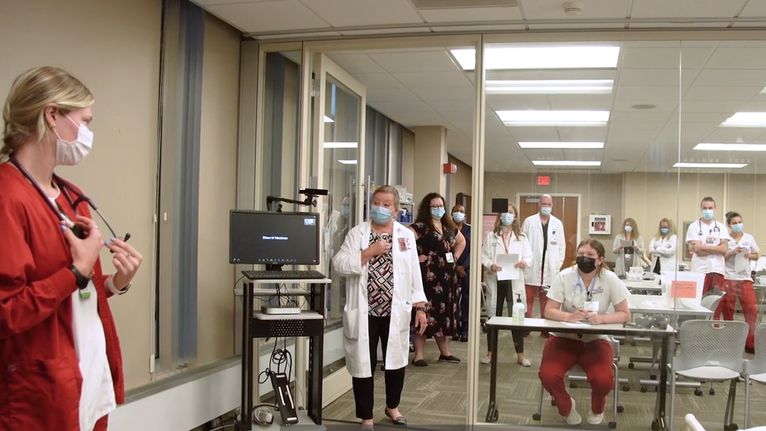UC Health Eases the Transition for Nurses
According to the National Council of State Boards of Nursing (NCSBN), health systems that have solid transition programs in place see better staff retention, as well as better patient outcomes.
The collaboration between the UC College of Nursing and UC Health Transplant eams recognized this need and developed a 200-hour simulation-based experience for accelerated direct entry Master of Science in Nursing (MSN) students who are about to start their final semester of the program. In this preceptor-guided clinical experience, students engage with both the UC Health Transplant and UC College of Nursing teams, where there is less personal stress.
Why focus on transplant simulation? Transplant patients have half of a dozen specialists dedicated to navigating their pre- and post-transplant care. The traditional transplant healthcare team consists of a surgeon, physician, social worker, dietician, pharmacist and a nurse—each one of them have subspecialized training for their specific role.
Nurses, like the other professionals within the team, must understand how their individual decision-making and collaboration will impact the entire multidisciplinary team and, subsequently, the patient.
“Students are going from discipline-specific skilled to team skilled,” Dr. Wagner explained. “You know how to be the nurse, but here you’ll learn how to be a nurse within a multidisciplinary team.”
Interprofessional Transplant Simulation
Twice a year, UC students team up with members of UC Health Transplant to walk through a variety of scenarios that a transplant patient could face as they are being discharged from the hospital.
The simulation focuses on communication and collaboration, as the simulation is an exercise that is less about teaching about the actual care delivered to the patient, and more about the team communicating with each other and thinking through their collective decisions. In this scenario, team members can slow down and see how they support each other and how, through teamwork, they can better support the patient together.
“One of the things we’re able to do outside of the clinical setting is control the environment,” Eileen Werdman, DNP, APRN, and associate professor and director of the accelerated direct-entry MSN Program at the UC College of Nursing said.
“When we do a simulation-based training, we have ultimate control. We can immerse the nursing student in the same environment over and over, so they have the opportunity to reflect on how they acted, and the decisions made, then be able to build upon it,” she continued.
UC Health Transplant team members participate in the simulation, and in partnership with simulation experts, encourage the students to ask questions and discuss why decisions were made for the specific patient and scenario—all within a protected environment where no patient safety is at risk. Simulation-based exercises can help mitigate the anxiety that nurses and clinicians may feel when entering in a new position.
The partnership between the UC College of Nursing and UC Health aims at alleviating some of these stressors and providing nursing students with a network of experienced mentors from a nationally ranked, high-functioning transplant team.
“Here in Transplant, we want to pique the students’ interest in choosing transplant as their specialty, but we want to show them the team aspect of taking care of a patient,” Jennifer Harris, MSN, RN-BC, clinical director of solid organ transplant at UC Health said. “We want to bring students in and prepare them side by side so that they feel comfortable and supported by our team.”
UC Health Transplant has nearly 55 years of experience providing heart, kidney/pancreas, and liver transplantation for adult patients in the Greater Cincinnati and Northern Kentucky region, providing thousands of people with a second chance at life.

